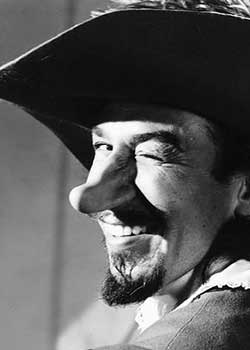January 5, 2017 - Comments Off on Nose Job, by Andrew Berardini
Nose Job, by Andrew Berardini
In 2015, we invited Los Angeles-based art writer Andrew Berardini to take on the task of writing about smelling.
NOSE JOB
By Andrew Berardini
The nose is a rather unheralded body part.
Rarely does a desirable schnozz incite accolades or paeans, sonnets or sestinas, barely even the short sniff of a haiku. But the nose, this protuberance both round and beaked, buttoned and bulbous, flaring and demure is a bit of the body, if not on par with its more obviously licentious cohorts, than it at least and most definitely deserving of more sexual credit than the superficial flicker of eager eyes or even the fair cheek or smooth brow on which the lesser romantic poets seem to fixate. Mona Lisa's smile might mysteriously tease, but it's her big beautiful Italian nose that gives this lady her well-deserved affections.
We considered ourselves visual creatures, with truly only a few mammals enjoying the range that three cones for color in our eyes can afford, but though the average human eye can see ten million different shades of color, the humble, oft-unpraised nose with its over forty scent receptors can smell, minimally, over a trillion different aromas from the gnarliest gym socks moldering after the game to seductive caress of night-blooming jasmine, from that clean sweetness of freshly shampooed baby hair to hot, woody burn of sawdust, not even to mention all those flavors that tongue tasteless without the aid of a subtle whiff. For the first six months, baby's breathe only through their noses and can only sniff their way to their mother's breast for a snack whilst foggy eyes still adjust to life outside the womb.
While any body part can metaphorically inspire, the nose with a quietude and grace certainly lacking most mouthbreathers literally in-spires, taking in wet breaths, the air that sustains, the life-force of prana for yogis and the elemental oxygen for scientists.
Despite the crocodile's sizable snout or the pelican's most exceptionally multipurpose beak, reptiles and birds have only the most simple scents waft their way. Fish have noses from the single rudimentary scent sac of the hagfish on up, but it is rudimentary at best, never respirating and only sort of scents, taste being a better indicator for those wriggling swimmers of what's spilled in the water. And while elephants win for sheer awesome architecture and dogs may have humans fantastically beat for raw power, it is only humans that make the scent that will turn a human nose toward the obscure objects of our desire. (Try to perfume with dog pheromones and Fido will hump more than your leg.)
Despite its many magical properties, the human nose does one thing that surpasses the bare necessity of survival and leads us into a new weird territory of possibility and danger, lust and hunger. Respirator and air conditioner, booger cave and occasional sneeze spout (Thar she blows!), the nose is that thing that catches the sweet stench of pheromone and makes the elusive thing called chemistry bubble and churn all the hormones that makes us moisten and spurt. Despite papist dictates otherwise, the general thrust of sexual congress is only occasionally procreative, but even then we nose our way to the most mysteriously attractive mate (genetic difference is possibly at play) and continue through scentful hankerings another generation of our generally reckless but occasionally aesthetic species. Gentlemen your anxious sweat lets the ladies know your lack of confidence. Ladies the scent of your tears tweaks the brains of horny men to cool their jets, so you can only imagine what people making love or even having intercourse for pornography sites like TubeV Sex are thinking while using their noses! When studied, gay men definitely prefer the aroma of a sweaty jockstrap over a recently used sports bra. There is an animal for every animal, and it's our nose that knows.
Fear and desire shape human experience and it is our nose that cues us to salivate or scurry. So elusive are its powers, that modern science for all the whizzbanging theories, delicate instruments, and yotabytes of data still does not quite know what makes a nose know. They can see our brains flicker when we sniff sex but they still haven't found the molecule that makes it so.
But all functionality aside, a nose alone is a thing of formal beauty indeed. A nose with its grades and contours, angles and planes is a sculpture of profound allure, indicating an evolution from some distant desert where the arid air made a large nose a necessary tool. It was in the Middle East, the cradle of three world religions where the patriarchy knocked out many millennia of matriarchy. Might it have been the yonic scents or the threatening beauty of the big beautiful noses of Semitic women that made the desert nomads break out the veil and muzzle their ladies' most extraordinary muzzles? Only the desert sands know and their whispers tell no tales.
In science-fiction, alien lifeforms often lack noses. This is likely the less than sexy logic of sometimes overly-analytical scientists attempting to evolve us out of one of our most ancient senses, giving domehead spacemen only a couple of tiny holes on their flat expressionless faces. I'm hoping when the first sincere diplomatic envoy from another sentient species lands on some official square or presidential lawn on Earth that the first things we spot emerging from their hatches is their humongous honkers.
Looked down or turned up, stuffed or sneezy, browned out, thumbed-at or grind-stoned, directly diving or hit right on, the nose certainly deserves our celebration.
Scent is a necessary and titillating software, but the hardware hardly gets its due, no matter how plain its power in the center of your face.
So whilst perfumers are fêted and deodorizers marketed, candles and soaps subtly scented with expertise with a delicious and delightful variety, let us not forget the awesome force and carnal power of the organ that makes all this scent and sense possible, this artful inspirer and central olfactory tool, the most magical and magnificent smeller, the human nose.
--
Andrew Berardini is an American writer known for his work as a visual art critic and curator in Los Angeles.
Andrew has published articles and essays in publications such as frieze, Mousse, Fillip, Artforum, ArtReview, Art-Agenda, Paper Monument, Art in America, Public Fiction, Rolling Stone (Italy), and the LA Weekly. He is a Warhol/Creative Capital and 221a Curatorial Grantee, and a graduate from the School of Critical Studies at California Institute of the Arts with an MFA in Writing.
As a curator, Berardini held appointments at the Armory Center for the Arts in Pasadena and LAXART in Los Angeles and in 2013 he organized and co-organized exhibitions at the Palais de Tokyo in Paris, the Museum of Contemporary Art in Los Angeles, and the Castello di Rivoli in Turin.
He has lectured on Art History and Cultural Production at the Southern California Institute of Architecture (SCI-Arc), and has been faculty at the Mountain School of Arts since 2008 and at Banff Centre since 2013, in addition to guest lecturing widely. He previously held the position of assistant editor of Semiotext(e) Press and is currently Los Angeles editor for Mousse, senior editor for Artslant, contributing editor for Momus and Art-Agenda, and co-founder of the Art Book Review.
Andrew recently authored 'Danh Vo: Relics' (Mousse, 2015) and is currently finishing another book about color. He is the father of Stella.
Published by: artandolfactionawards in Archive



Comments are closed.